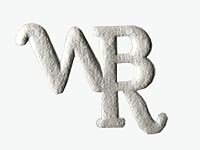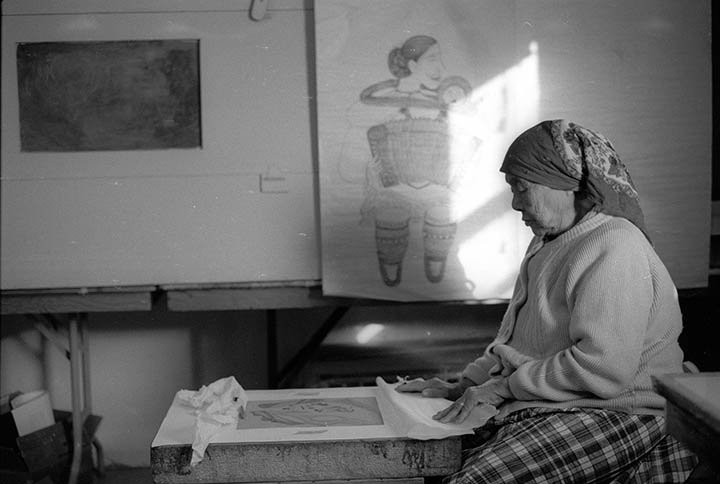Other forms of Printmaking at Kinngait Studios
Screen Printing, Silkscreen or Serigraphy
Silkscreen or serigraph was first introduced in 1964. While inventorying the archives at Kinngait Studios I kept track of when silkscreen prints occurred to see when the process peaked and then inevitably faded away.
In 1964 there is a record of Ulayu's image the title is "A woman tending fire". Another is by Kenojuak titled "Birds I imagine". There are 17 proofs in the drawers so I expect it either didn't work out so well or it didn't sell. I'll try to get a photo of the actual prints but in the mean time here is one from 1965.
The artist is on top of the stack, Sharni, the printer in the middle is Iqaluk and the studio chop in black.
A sample of the image.
Early textile printing and prints on paper
There was a fair amount of time and energy put into developing screen printed fabric in the studios. We have a large box full of off cuts that are really remarkable. There are quite a few historic photographs showing the printers engaged in this activity.
I am not sure how fabric printing was considered for production at the studios. Terry Ryan left no stone unturned in the quest for a viable creative enterprise that would reflect the beautiful art work pouring out of the Dorset artists. I am almost certain that the impetus for this experiment has a face however, I just have never heard it mentioned before. There is a thesis out there for somebody that feels the need to fill in the blanks.
Lucta and Iqaluk Pingwartok :photo Terry Ryan
Mark Pitseolak photo Terry Ryan
Meeting on and around the fabric printing table. :photo Terry Ryan collection.
Siqpik aka Bob Paterson and Iqaluk Pingwartok, fabric hung to dry. photo:Terry Ryan
Manumikutaa Saarruk, more fabric designs. photo:Terry Ryan
Ventilation
I thought it was about time to install a purpose built ventilation system in the studios. Mind you someone did install a fan vent for the Nitric acid bath that was used for etching long before I arrived and there is a blocked hole where a vent went out over the graining sink but they (fans) have all been removed. (Since writing this I have learned that Paul Machnik tried to use the graining sink as a platform for etching plates and the vent pipe was his solution to ventilation.) There was always the "open door technique" when the fumes became unbearable but by the time someone realized there were too many fumes everyone in the studio was saturated. When the temperature outside dropped to -40C opening the door wasn't really an option and neither was my first invention to extract the fumes away from the end of the litho press nearest the inking position. Mike Perry fabricated some heating duct work so that the intake was right where the press meets the table so to capture the fumes at the source during clean up and processing procedures. The cold temperatures would use the pipe to migrate into the building causing the sponges and water bowls to freeze solid. The pipes were subsequently filled with rags and the fan was never turned on during the very cold months which is most of the production period. The exhausted heated air would also cause an ice accumulation where the heat and cold met out of doors. When the ice got too thick it would block the vent and it needed to be chipped free...which rarely happened so it turned out to be a bad idea.
Rob Harmer took up the challenge when he took my place in 1990-91 (?) and motivated for a portable Nederman unit that could be rolled into position. It took up a lot of precious room, was very loud and it relied upon a huge filter to capture the solvent. After it was on for a period of time it put out a strange smell so it was rarely used.
When I returned in 1995 I complained so much to Terry Ryan that I was given the ok to install a fixed Nederman ventilation system and it is used all day everyday for many years now. Over time the printers learned to use the vents all the time knowing that solvents in our bodies wasn't a good thing. It isn't perfect however. Sending the heated air from inside the studios out into the arctic air just make the furnaces (three) work harder and the negative pressure sucks air into the building from the many holes and poorly insulated walls. I expect a heat exchange system would work best. The outgoing hot air would warm the incoming cold air to help with wasted heat loss but for now we are happy getting a large percentage of the solvents out of the work area.
Etching, Intaglio
Interest in etching seemed to come early. There are photos of Houston pulling prints from the small Canadian Mint etching press. Terry managed to acquire a used press from the Canadian mint, we still have it. Since it was purpose built to proof money the size of the pressure drum and the bed were obviously pretty small. The pressure drum had a felt blanket attached to it and it had a ships wheel to pull the impression through the press process.
Lucta and Ninguatsiak printing on the Canadian Mint etching press
Preparing copper etching plates for printing. Who thought painting the surfaces navy blue was a good idea? In mid winter this must have been a very dark space to work in.
When I arrived in 1988 Kooju was the only person working in the etching area. She would make three of four prints a day and eventually somebody realized that it wasn't a very cost effective process. By that time there was two Charles Brand etching presses, one that could print 22"x30" and another small press that could print 8x10" plates.
I used the aquatint box, hot table and the presses a few times to make my own prints but eventually the aquatint box and the enclosure for the acid tray were dismantled. The two newer presses are still used today by Paul Machnik when he comes every two years to develop etching images for the annual collection.
In the photo below you can see the carefully made aquatint box and beside it was the acid cabinet. In the cabinet a dilute solution of nitric acid and water (7:1) was decanted into a fiberglass tray deep enough to submerge a thin copper, zinc or even steel plate. You can also see the rough sketch that Napachie Pootoogook made for what became her much sought after lithograph called "My first accordion"released in 1989.
Atami Regge drawing on a litho stone. Note in the background is the aquatint box and to the right behind the drawing by Napachie of her accordian lady is the old acid bath compartment. This photo is a scan of a black and white negative I took "back in the day".
Below Pudlo Pudlat was asked to come in and model for Napachie's drawing. I can't remember if it was Pudlo's accordion or Napachie's? Pudlo sat quietly as Napachie sketched and then he broke into a jig or a reel and the whole place turned into a party. Behind Pudlo you can clearly see the plexi doors of the acid bath with some fiberglass trays stacked inside. This booth was vented to the outdoors with a simple bathroom type exhaust fan attached to a piece of furnace pipe. As another aside, below the table in the background you can see the galley case tipped on it's side, it was used to store etching plates because none of us knew it's correct function. Wil Hudson made that rack and now it sits along side the rest of the Letterpress equipment.
Tutuja Jaw printing etchings under Paul’s supervision.
















